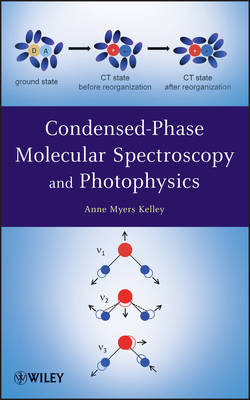
Condensed–Phase Molecular Spectroscopy and Photophysics
John Wiley & Sons Inc (Hersteller)
978-1-118-49305-2 (ISBN)
- Titel ist leider vergriffen;
keine Neuauflage - Artikel merken
ANNE MYERS KELLEY earned a BS in chemistry from the University of California, Riverside, in 1980 and a PhD in biophysical chemistry from the University of California, Berkeley, in 1984. Following postdoctoral work at the University of Pennsylvania, she held faculty positions at the University of Rochester (1987-1999) and Kansas State University (1999-2003) before becoming one of the founding faculty at the University of California, Merced, in 2003. Her primary research area has been resonance Raman spectroscopy, linear and nonlinear, but she has also worked in several other areas of spectroscopy including single-molecule and line-narrowed fluorescence, four-wave mixing, and time-resolved methods. She is a Fellow of the American Physical Society and the American Association for the Advancement of Science.
Preface 1. Review of Time-Independent Quantum Mechanics A. states, operators, and representations B. eigenvalue problems and the Schrodinger equation C. expectation values, uncertainty relations D. particle in a box E. harmonic oscillator F. the hydrogen atom and angular momentum G. approximation methods H. electron spin I. Born-Oppenheimer approximation J. molecular orbitals K. energies and time scales, separation of motions 2. Electromagnetic Radiation A. classical description of light B. quantum mechanical description of light C. Fourier transform relationships between time and frequency D. blackbody radiation E. light sources for spectroscopy 3. Radiation-Matter Interactions A. the time-dependent Schrodinger equation B. time-dependent perturbation theory C. interaction of matter with the classical radiation field D. interaction of matter with the quantized radiation field 4. Absorption and Emission of Light by Matter A. Einstein coefficients for absorption and emission B. other measures of absorption strength (absorption cross-section, Beer-Lambert Law) C. radiative lifetimes D. oscillator strengths E. local fields 5. System-Bath Interactions A. phenomenological treatment of relaxation and lineshapes B. the density matrix C. density matrix methods in spectroscopy D. exact density matrix solution for a 2-level system 6. Symmetry Considerations A. qualitative aspects of molecular symmetry B. introductory group theory C. finding the symmetries of vibrational modes of a certain type D. finding the symmetries of all vibrational modes 7. Molecular Vibrations and Infrared Spectroscopy A. vibrational transitions B. diatomic vibrations C. anharmonicity D. polyatomic molecular vibrations; normal modes E. symmetry considerations F. isotopic shifts G. solvent effects on vibrational spectra 8. Electronic Spectroscopy A. electronic transitions B. spin and orbital selection rules C. spin-orbit coupling D. vibronic structure E. vibronic coupling F. the Jahn-Teller effect G. considerations in large molecules H. solvent effects on electronic spectra 9. Photophysical Processes A. Jablonski diagrams B. quantum yields and lifetimes C. Fermi's Golden Rule for radiationless transitions D. internal conversion and intersystem crossing E. intramolecular vibrational redistribution F. energy transfer G. polarization and molecular reorientation in solution 10. Light Scattering A. Rayleigh scattering from particles B. classical treatment of molecular Raman and Rayleigh scattering C. quantum mechanical treatment of molecular Raman and Rayleigh scattering D. nonresonant Raman scattering E. symmetry considerations and depolarization ratios in Raman scattering F. resonance Raman spectroscopy 11. Nonlinear and Pump-Probe Spectroscopies A. linear and nonlinear susceptibilities B. multiphoton absorption C. pump-probe spectroscopy: transient absorption and stimulated emission D. vibrational oscillations and impulsive stimulated scattering E. harmonic and sum frequency generation F. four-wave mixing G. photon echoes 12. Electron Transfer Processes A. charge-transfer transitions B. Marcus theory C. spectroscopy of anions and cations 13. Collections of Molecules A. van der Waals molecules B. dimers and aggregates C. localized and delocalized excited states D. conjugated polymers 14. Metals and Plasmons A. dielectric function of a metal B. plasmons C. spectroscopy of metal nanoparticles D. surface-enhanced Raman and fluorescence 15. Crystals A. crystal lattices B. phonons in crystals C. infrared and Raman spectra D. phonons in nanocrystals 16. Electronic Spectroscopy of Semiconductors A. band structure B. direct and indirect transitions C. excitons D. defects E. semiconductor nanocrystals Appendices A. Physical constants, unit systems and conversion factors B. Miscellaneous mathematics review C. Matrices and determinants D. Character tables for point groups E. Fourier transforms
| Verlagsort | New York |
|---|---|
| Sprache | englisch |
| Maße | 150 x 250 mm |
| Gewicht | 725 g |
| Themenwelt | Naturwissenschaften ► Chemie ► Analytische Chemie |
| Naturwissenschaften ► Physik / Astronomie | |
| Technik ► Maschinenbau | |
| ISBN-10 | 1-118-49305-2 / 1118493052 |
| ISBN-13 | 978-1-118-49305-2 / 9781118493052 |
| Zustand | Neuware |
| Informationen gemäß Produktsicherheitsverordnung (GPSR) | |
| Haben Sie eine Frage zum Produkt? |